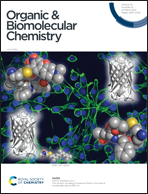Cholesteryl glucosides signal through the carbohydrate recognition domain of the macrophage inducible C-type lectin (mincle)†
Abstract
Cholesteryl α-D-glucosides (αGCs) are unique metabolic products of the cancer-causing human pathogen Helicobacter pylori. Via signalling through the Macrophage inducible C-type lectin (Mincle) and the induction of a pro-inflammatory response, they are thought to play a role in the development of gastric atrophy. Herein, we prepared the first library of steryl D-glucosides and determined that they preferentially signal through the carbohydrate recognition domain of human Mincle, rather than the amino acid consensus motif. Lipidated steryl D-glucosides exhibited enhanced Mincle agonist activity, with C18 cholesteryl 6-O-acyl-α-D-glucoside (2c) being the most potent activator of human monocytes. Despite exhibiting strong Mincle signalling, sito- (5b) and stigmasterol glycosides (6b) led to a poor inflammatory response in primary cells, suggesting that Mincle is a potential therapeutic target for preventing H. pylori-mediated inflammation and cancer.

- This article is part of the themed collection: Chemical Biology in OBC


 Please wait while we load your content...
Please wait while we load your content...